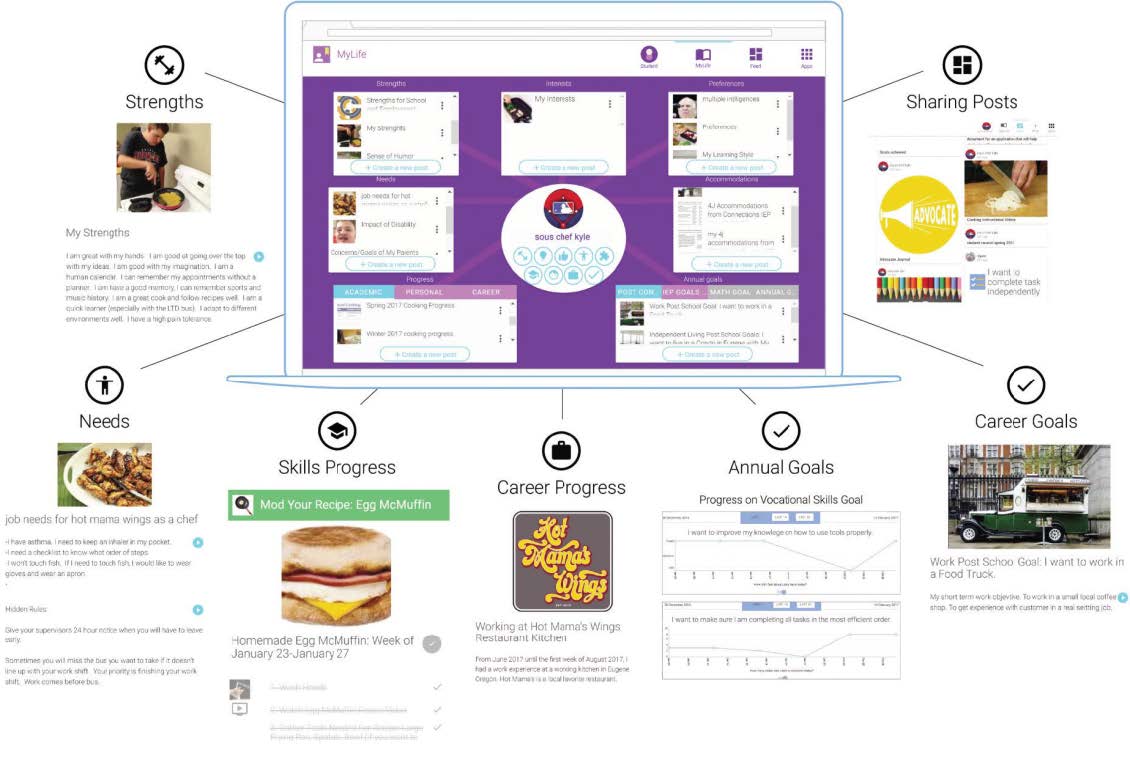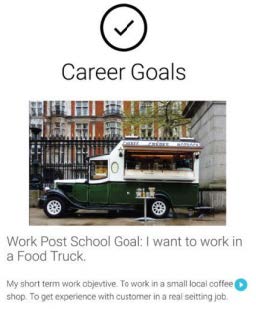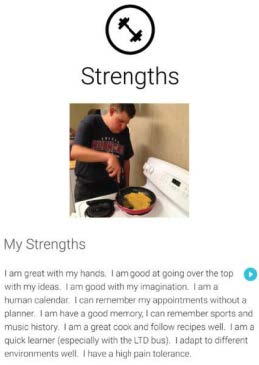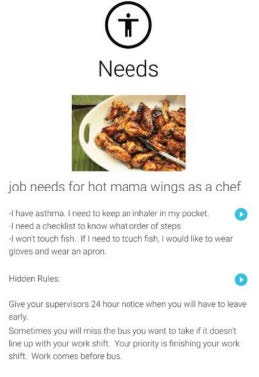
Self-determination is the combination of personal knowledge, skills, beliefs, and attitudes that empower an individual to have increased personal autonomy, decision-making, and involvement in goal setting when planning for their future.
Research in the area of self-determination supports the value of student involvement in the IEP process and transition planning. In return, studies have shown that students who are more actively involved in their transition planning are more self-determined. An individual's ability to express their strengths and preferences, as well as increased personal autonomy, are all predictors for positive outcomes in employability and community access.
Teacher-facing instructional materials are available to promote self-determination and person-centered planning tools help to facilitate transition planning and increase student involvement. There is an unmet need, however, for self-management applications in this area that are accessible to students and adults with cognitive disabilities and specifically designed for use by them. We believe that in order to build a sense of selfdetermination, individuals need tools that enable them to behave in self-determined ways.
To date, little attention has been given on precisely how to enhance the ability of individuals with cognitive disabilities to actively participate in updating, creating, and documenting activities related to their IEP and employability on an ongoing basis. Accessible applications can be utilized in this area to increase student participation in self-directed IEP development and ongoing transition self-assessment. Our experiences have shown that students have a better understanding of their IEPs
and take increased leadership roles in facilitating their meetings when they actively use technology that supports self-direction and participation.

TAKING CHARGE: (Above) The MyLife interface provides a graphic framework for an IEP, allowing for students to their own ongoing selfassessments, be involved in the creation of their annual IEP goals, and advocate for themselves in their own words. (Opposite page) Kyle, a second-year transition student with a post school career goal of becoming a sous chef and working in a food cart, documented his goals and illustrated his strengths in cooking through a video that showed the many foods he'd prepared at school and at home.
A Tool for IEP Self-Direction
Often transition-aged students report they have little to no understanding of contents of their own IEP. During the IEP meeting they are sometimes surprised at contents regarding their abilities and behavior. While students are required to attend their IEP meetings once they reach age 18, many are often passive and disengaged participants.
To address this challenge, we recruited a group of 23 transition students to work with us on developing MyLife, a web-based ePortfolio for IEP self-direction over a period of two years. All of the students have been (or are currently) enrolled in the 4J Connections program, a local transition program serving 18- to 21-year-old adults who did not receive a regular diploma. 4J Connections students experience a wide range of disabilities including cognitive impairments, learning disabilities, emotional disturbance and autism spectrum disorders.
Building their own ePortfolios through MyLife, students met with 4J Connections staff members at least once a week to check in and work on creating and adding content within the app. This
person-centered, student-directed approach reflects the IDEA mandate that appropriate and measurable postsecondary goals be based on transition assessments, with an emphasis on ongoing transition assessment through student-generated data based on strengths, needs, preferences, interests, accommodations, and goal progress.
We began our initial research by giving each student a hard copy of their IEP and asking them how much of its contents they were familiar with. The answer was very little. In discussing their IEP goals it became clear that while they were interested, the actual IEP was not a user-friendly document that made sense to them. We also asked them to discuss their participation in the IEP meeting. All of the students were present at their meetings, but they described their participation as ranging from completely passive to disengaged. These insights formed the starting point for developing MyLife with two overall requirements:
1. Create a tool that would enable students to understand and track their IEP goals in their own way through words, images, videos, audio, web links, PDFs or other media.
2. Provide tools that make it possible for students to lead their own IEP meetings.
We hypothesize that enhanced participation and self-direction in the IEP process can result in improved self-advocacy and self
determination and that MyLife could provide this capability. At a broad level, MyLife is a cognitively accessible ePortfolio that students and their support teams can utilize for documenting and sharing individual strengths, interests, preferences, and needs by accumulating personalized multimedia content ranging from videos to photos, to rating scales and individualized transition assessments.
When developing the functional requirements for MyLife, we sought to address the idea that commercial ePortfolio applications are not designed for cognitive accessibility or to facilitate IEP self-direction. Within the MyLife ePortfolio, however, students can share information directly with team members and adult service providers, run their own IEP meetings, and participate directly in their ongoing transition assessment and planning. Work, school, and volunteer experiences can be documented and shared with employment specialists in order for individuals to pursue customized employment opportunities.
MyLife is designed to be cognitively accessible and integrates elements of universal design and assistive technology like speech recognition input and text-to-speech output to accommodate for unique learning styles. On the back end, a Support Hub provides teachers, parents, and caregivers with a window into the student's activities and serves as a platform for assistance and encouragement as it is needed.
Serving as a roadmap for a student's future plans, the MyLife ePortfolio is centered on self-determination in a way that that emphasizes interagency linkages, person-centered plans and goal setting. We often describe it as a digital storytelling tool for transition across educational phases and settings. Enhanced self-direction has the potential to improve student, parent, and teacher satisfaction with the IEP.
Students at Connections have utilized MyLife to track their current and future work goals, post-secondary education, independent living, and personal and social environments. The MyLife interface provides a graphic framework for an IEP, allowing for students to their own ongoing self-assessments, facilitate and direct their own IEP meetings, be involved in the creation of their annual IEP goals, and advocate for themselves in their own words.




GROWTH CHART: Kyle's post connections goals, strengths (cooking), job needs, and career progress. Kyle used MyLife to take a leadership role in running his IEP meeting and continues to develop important skills in self-advocacy.
MyLife posts may be shared via email, text, or directly to an established connection within the Cognitopia Platform of apps. Further, the posts appear in a shared bloglike feed through which teachers, parents, and friends can see real-time updates. MyLife may also be used in conjunction companion application with the GoalGuide to document activities as well as to track progress on personal goals in
budgeting, problem-solving, and social skills.
Consider Kyle, a second-year transition student with a post school career goal of becoming a sous chef and working in a food cart. Within MyLife, Kyle documented this goal and illustrated his strengths in cooking through a video that showed the many foods he'd prepared at school and at home. When the opportunity arose to interview for a summer job at a local café, he discussed his Needs for that job with his teacher as well as some of the hidden rules of the workplace. He was also able to share his Strengths video with his transition team and potential employer, emphasizing his transferable job skills. And finally, he was successful in getting hired for his first paid work and documented it through a post with images and video on his Career Progress page.
Key Outcomes
At his recent IEP meeting, Kyle used the built-in meeting agenda and presentation tools within MyLife to discuss his goals, progress, needs, accommodations, and accomplishments with his parents, teachers, and other transition team members—taking a leadership role in running the meeting and continuing to develop important skills in self-advocacy. To date, twenty-three students in this project have used MyLife to lead their IEP meetings.Without exception, these meetings have been viewed as far more productive and positive processes by the students, parents, teachers, and school dis
trict administrators. The students have gone from passive participants, being talked at and around, to leading the IEP meeting, and even getting excited about the opportunity. Upon meeting his teacher in a school hallway and being asked how he was doing, one student said, "I have my IEP meeting today and I can't wait!" Similarly, parent satisfaction at seeing students expressing themselves is under
scored in this quote from a mother whose son spent his prior year's IEP meeting completely disengaged and largely preoccupied with the room's lighting controls. That same student spent a solid twenty minutes leading the IEP team through his MyLife portfolio in this year's meeting. Afterward, his mother emailed the teacher to say,"When I saw another student share his portfolio at an information meeting at the beginning of the school year, I couldn't see my son being able to do that. Now I just did. Thank you for a great IEP meeting." When he shared that quote with us, the teacher wryly commented, "You need to know that I never get thank you notes after IEP meetings."
Note: MyLife, Goal Guide, and other Cognitopia apps can be found at cognitopia.com and are available on an extended free trial basis. The Cognitopia platform is a suite of web-based applications designed to build self-determination that is being used in elementary, middle school, high school, and postsecondary settings. Preliminary findings indicate it is effective in enabling students to be more independent in managing the activities of daily living, school, and work in a way that fosters independence while providing teachers, parents, and others in supportive roles with a means to provide support when needed. The platform currently includes MyLife for IEP self-direction, Goal Guide for accessible goal management, Do for simplified scheduling and task prompting, and ScanDo for video modeled instructions when and where you need it.
Acknowledgements: This work has been supported in part by grant funding from: U.S. Department of Health and Human Services, Administration on Community Living, National Institute on Disability, Independent Living, and Rehabilitation Research Award Numbers 90BI0008 and 90IF0080. U.S. Department of Education, Institute for Education Sciences Award Number R324A160252. The content and views expressed are solely the responsibility of the author and do not necessarily reflect the official views of the funding agency.•